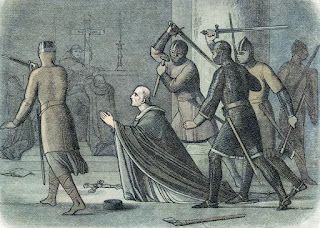Historical Plot of “Murder in the Cathedral”
Introduction
T.S. Eliot's "Murder in the Cathedral" is a historical drama that delves into the events leading to the assassination of Archbishop Thomas Becket in 1170. The historical plot of the play provides a backdrop for exploring themes of martyrdom, spiritual conflict, and the struggle between religious and secular authority.
The historical context of the play is crucial for understanding the significance of Becket's martyrdom. Becket was a close friend of King Henry II of England and initially served as Chancellor, a political position. However, after being appointed as Archbishop of Canterbury, Becket experienced a profound spiritual transformation, leading to a rift with the king. This historical tension forms the foundation of the play's conflict between religious duty and political allegiance.
The play opens with Becket's return to Canterbury from exile, setting the stage for his impending martyrdom. The historical backdrop highlights the power struggle between Church and state, as King Henry II seeks to assert control over the Church's authority. Becket's decision to resist the king's interference underscores his commitment to preserving the independence and spiritual integrity of the Church.
 |
| "Murder in the Cathedral" (Thomas Becket murder scene) |
The historical plot is punctuated by the Four Tempters who visit Becket, offering him various alternatives to his chosen path of martyrdom. These temptations are historically significant as they mirror the real challenges Becket faced—temptations of personal safety, political compromise, and material wealth. These interactions provide insight into Becket's internal struggles as he grapples with the conflict between his religious beliefs and his personal desires.
The historical plot also highlights the tension between Becket and the king's knights, who perceive Becket as a threat to the king's authority. The knights' resentment towards Becket culminates in the climactic murder scene within Canterbury Cathedral. This historically grounded event underscores the stakes of Becket's resistance against the king's encroachments and the ultimate sacrifice he makes for his convictions.
Eliot's meticulous attention to historical accuracy enhances the resonance of the play's themes. The characters' names, the political dynamics, and the broader historical context are portrayed with fidelity, allowing readers and audiences to engage with the profound struggle between religious and secular forces. Becket's martyrdom becomes a symbol of the enduring conflict between divine principles and human ambitions, transcending its historical context to speak to universal ethical dilemmas.
Conclusion
In conclusion, the historical plot of "Murder in the Cathedral" provides a rich tapestry against which the themes of martyrdom, spiritual conviction, and the tension between religious and secular authority unfold. The play masterfully navigates the historical events surrounding Becket's assassination while also offering a timeless exploration of the human struggle to uphold principles in the face of political pressures. The historical backdrop serves as a canvas on which the complex interplay between faith, power, and sacrifice is vividly portrayed, inviting audiences to contemplate the significance of Becket's story within the broader tapestry of history and human experience.
.jpeg)

Comments
Post a Comment